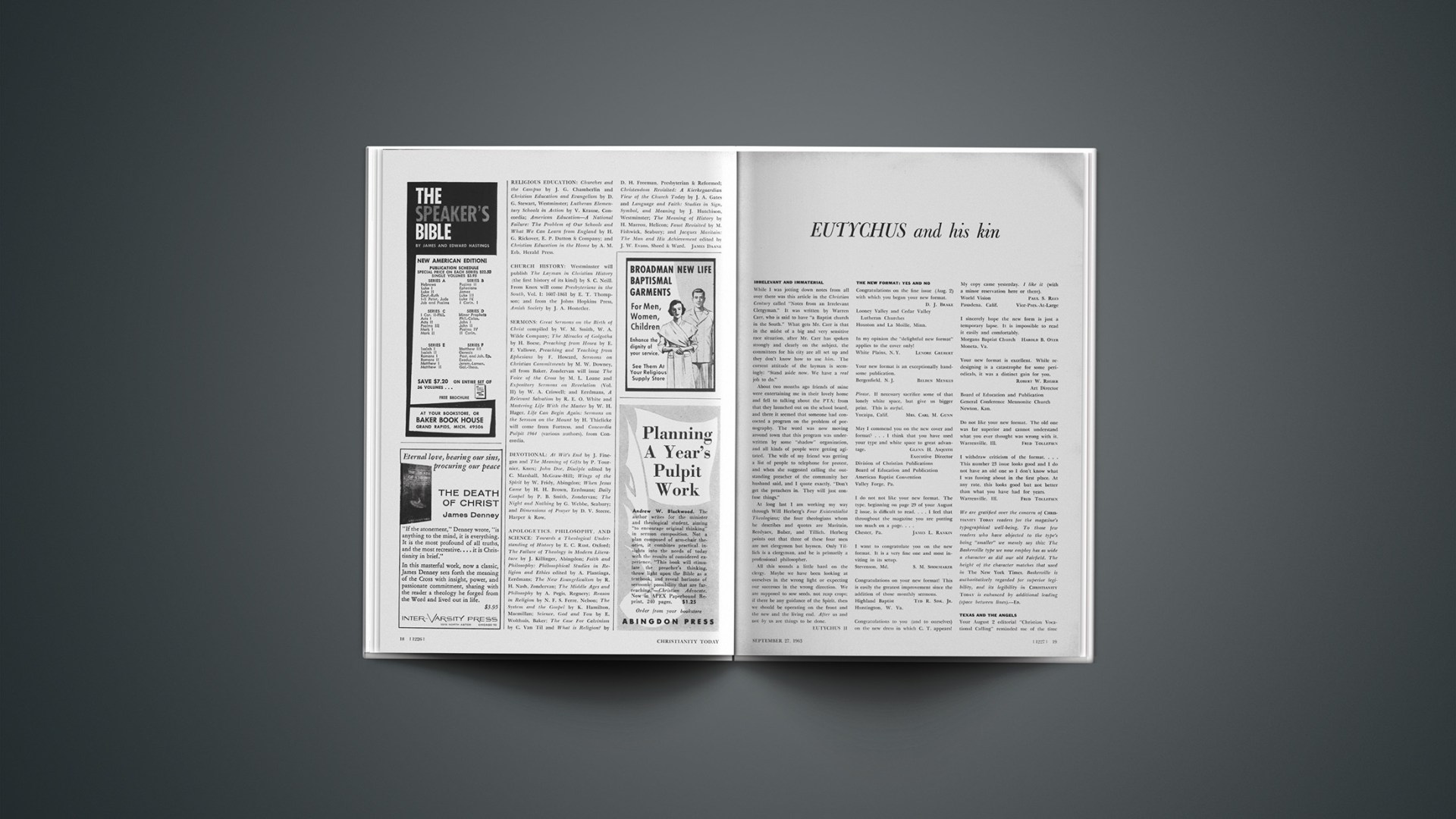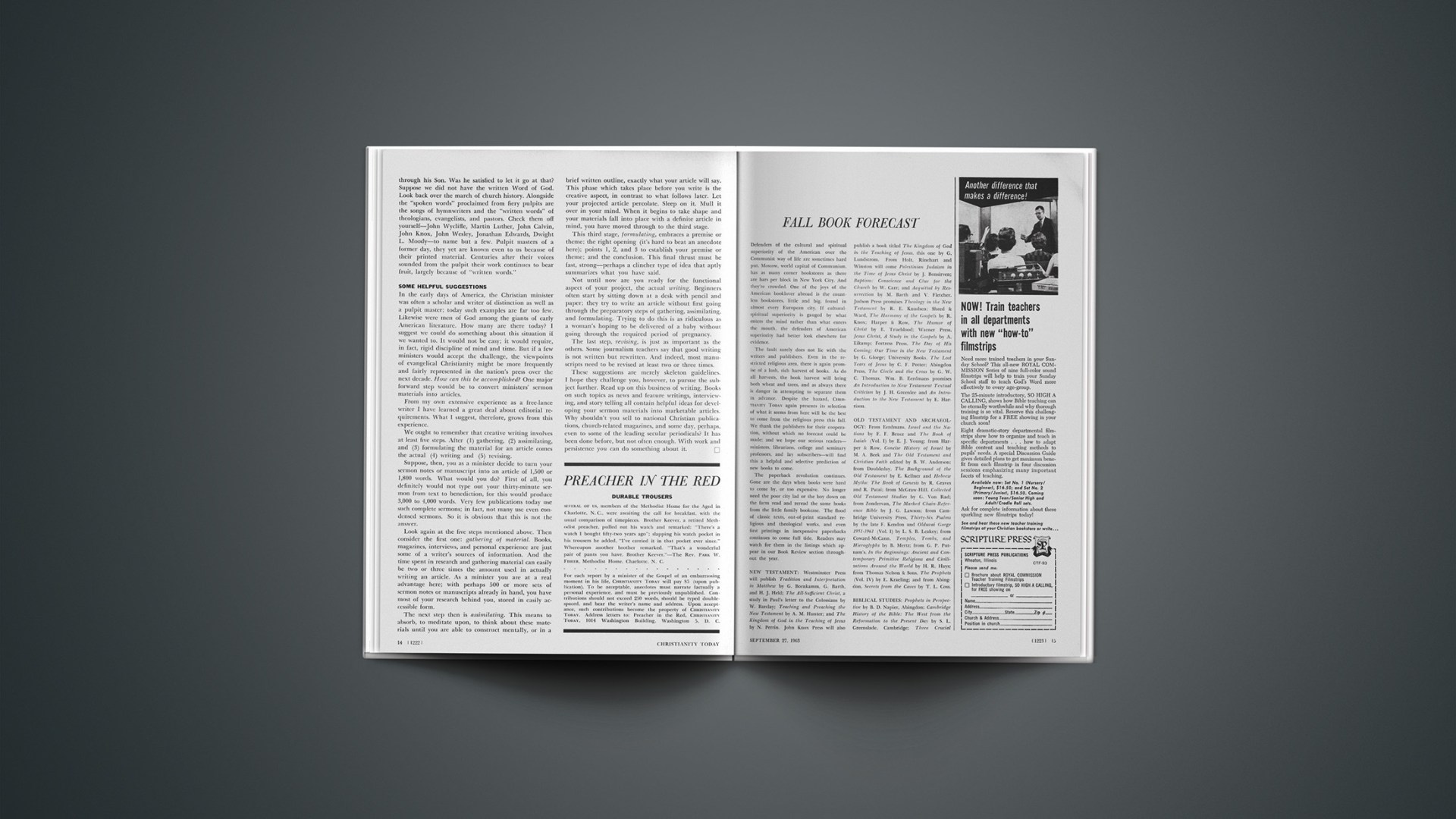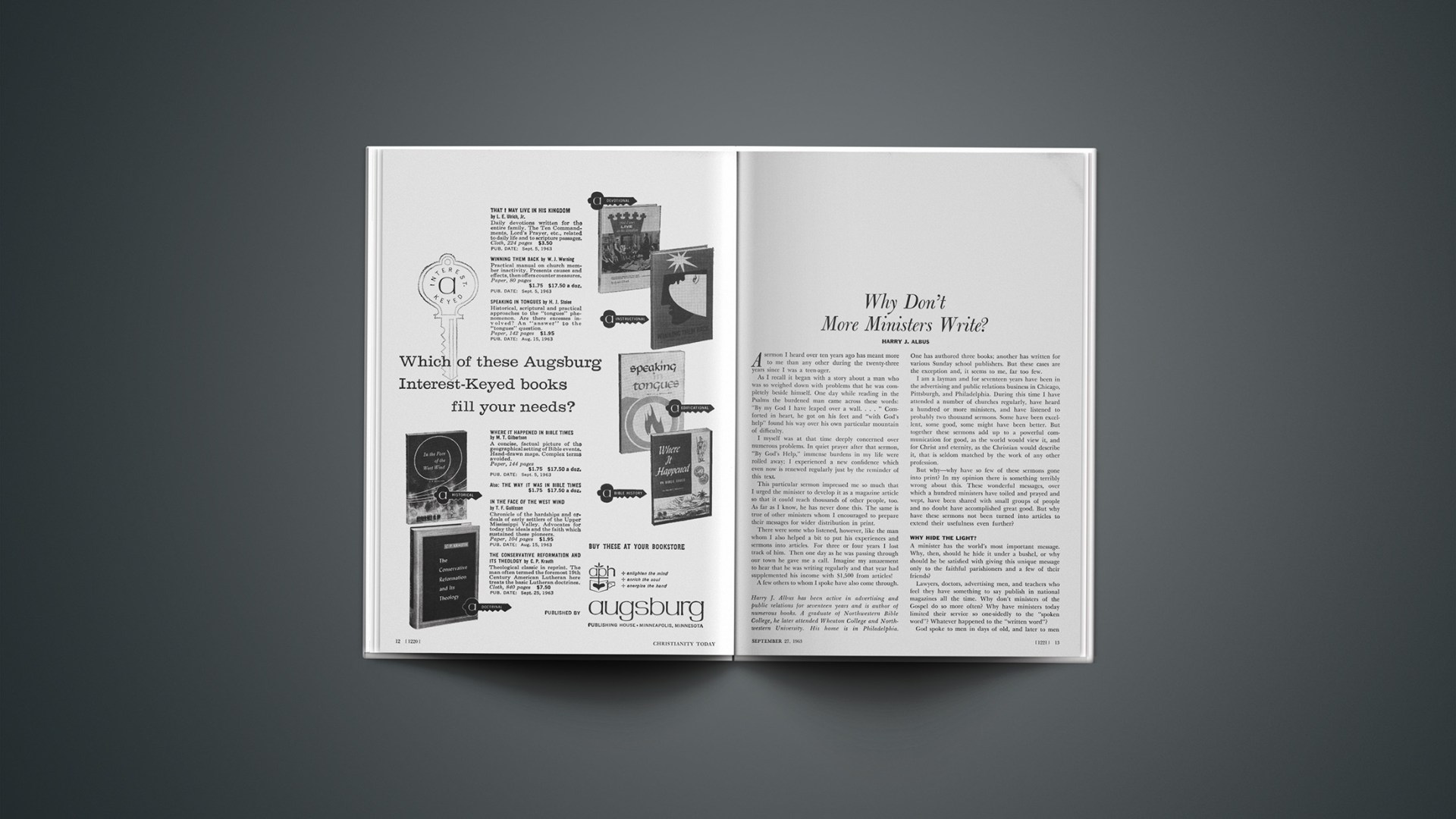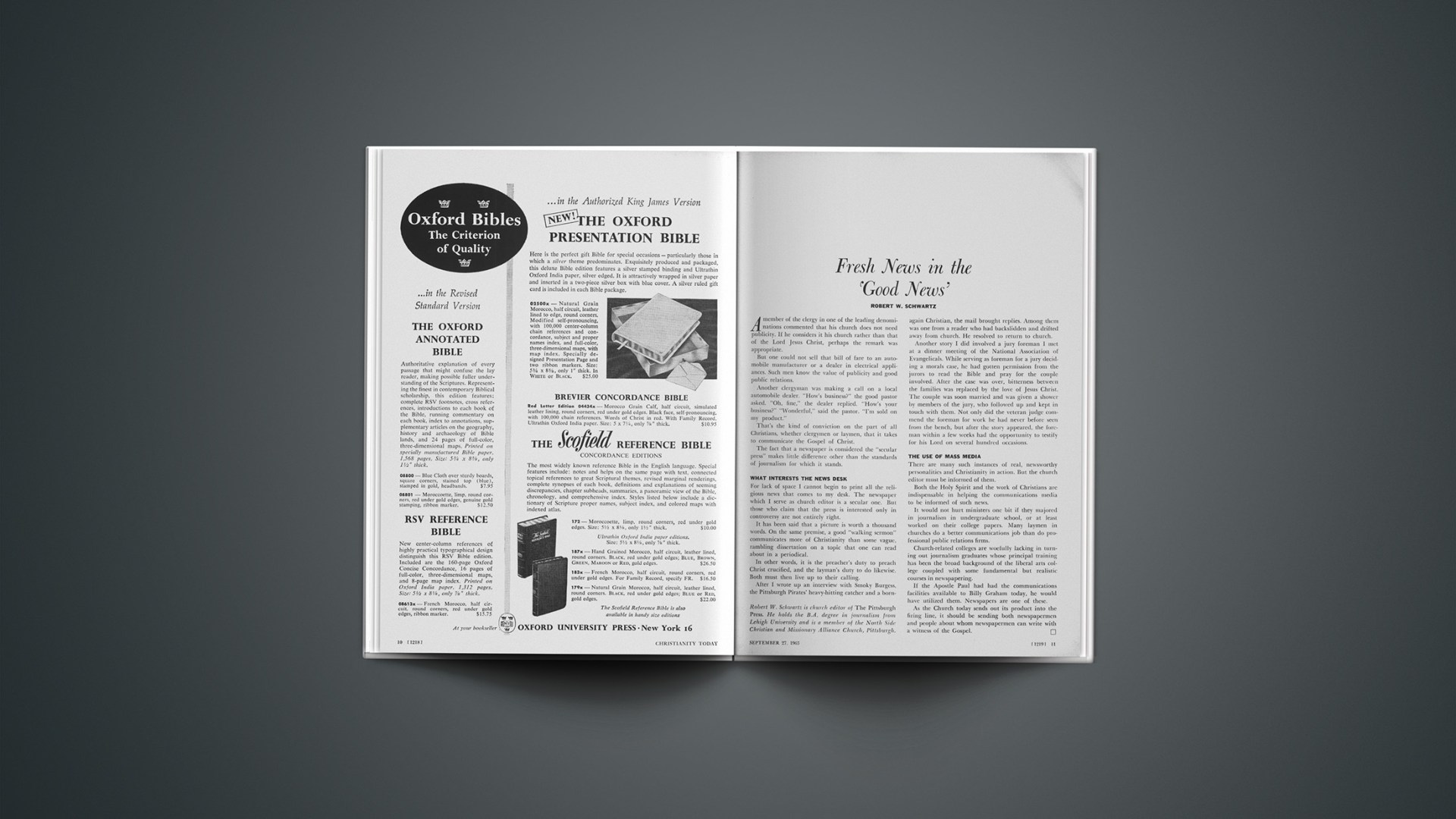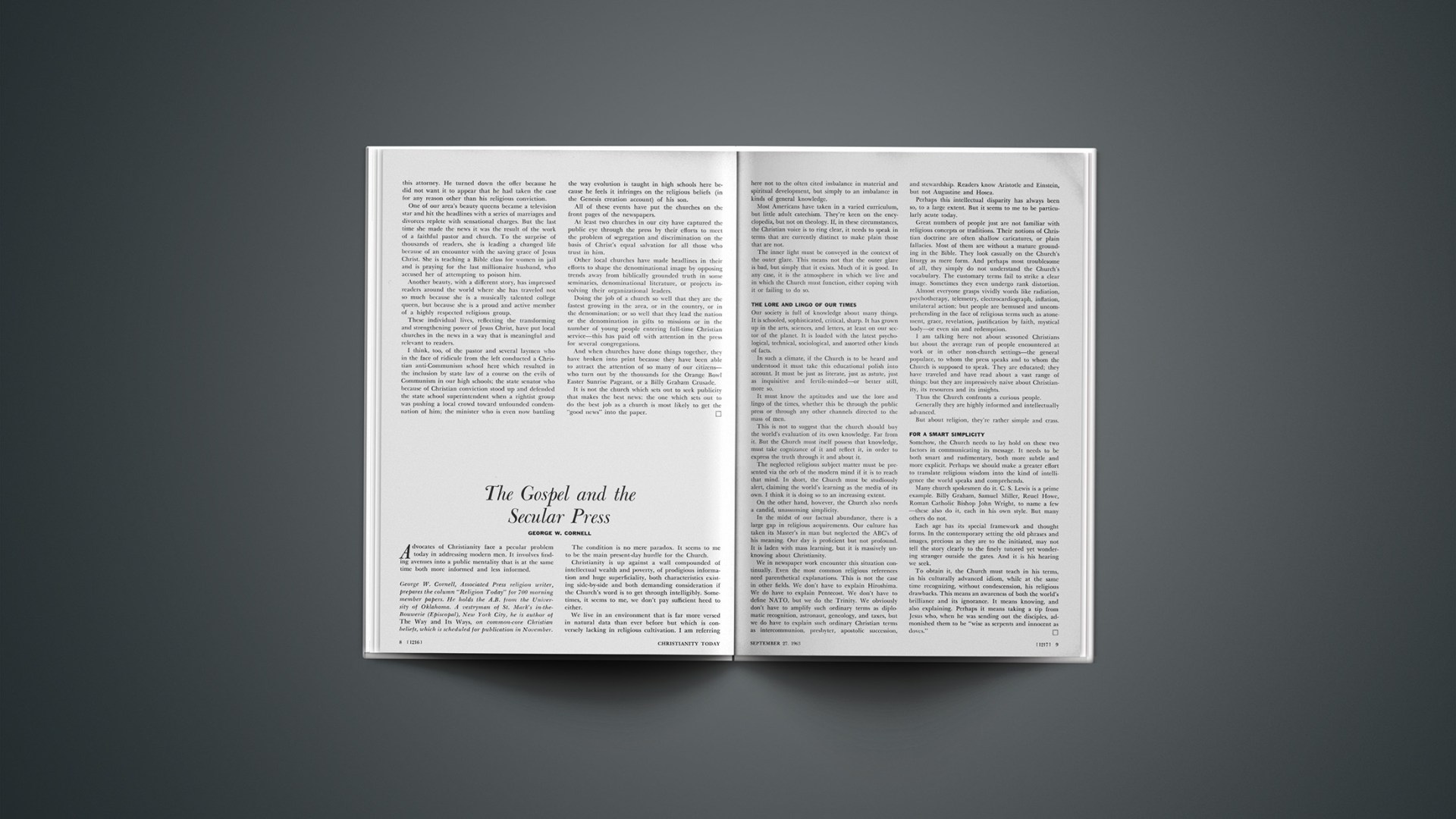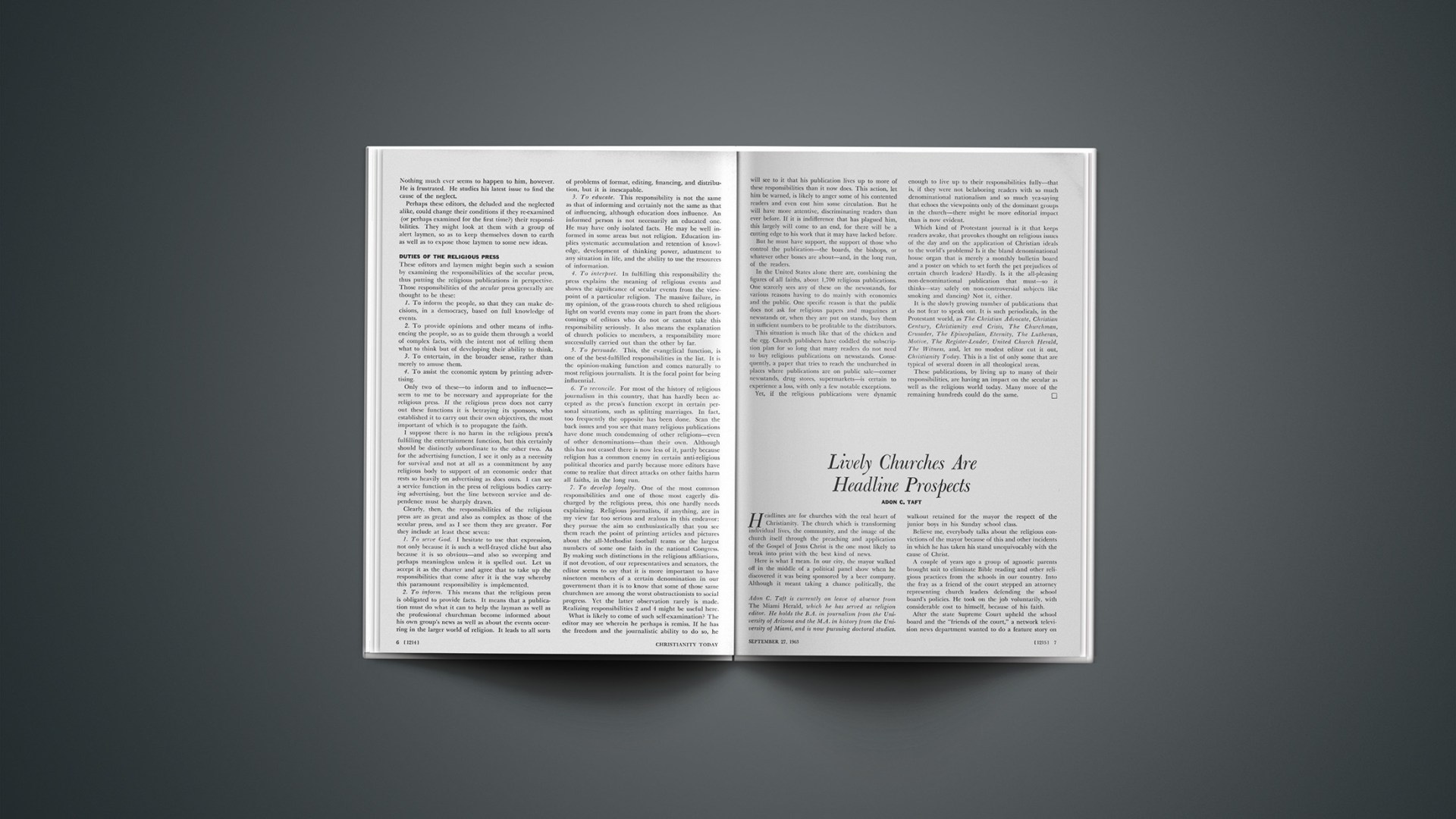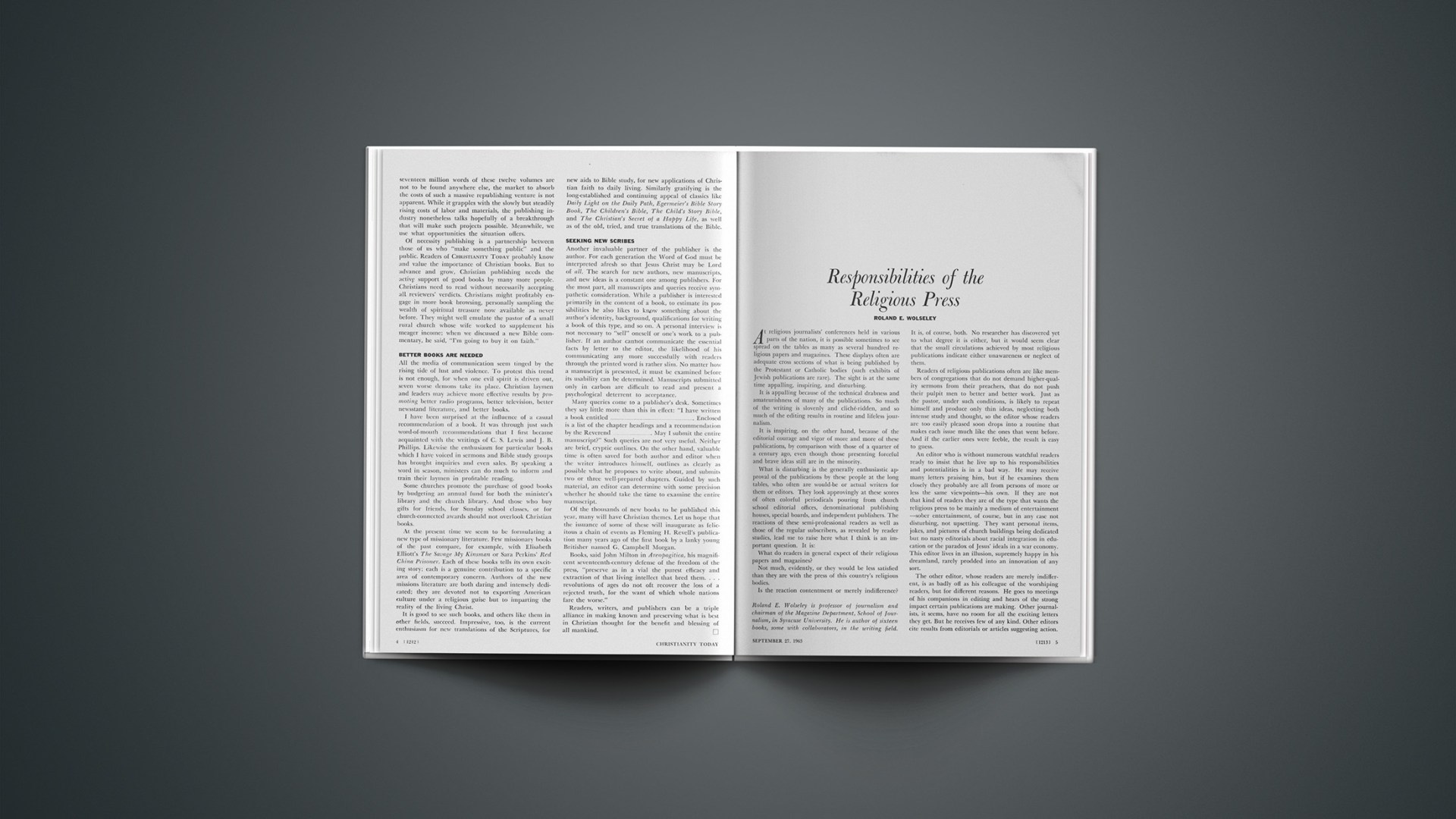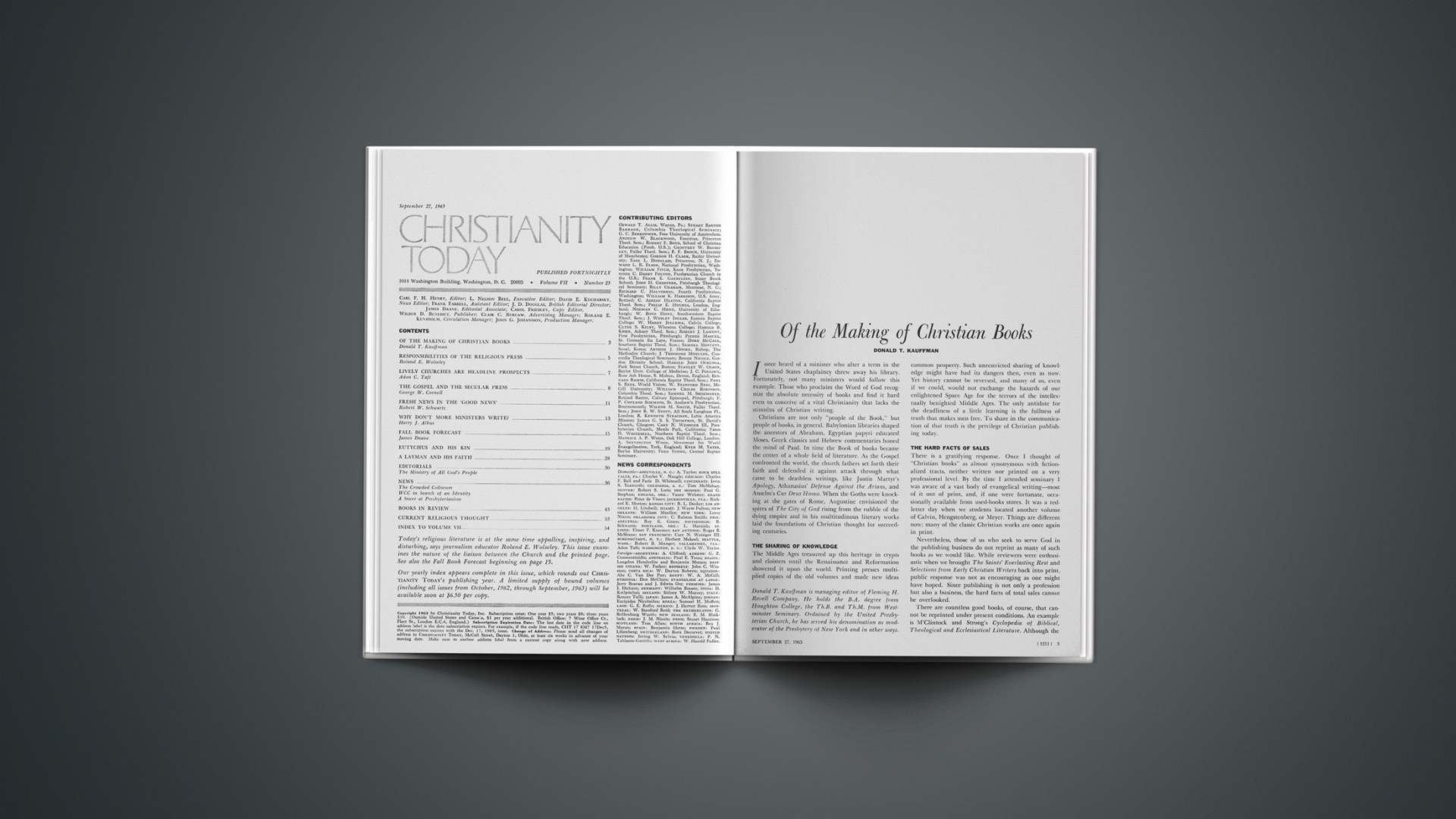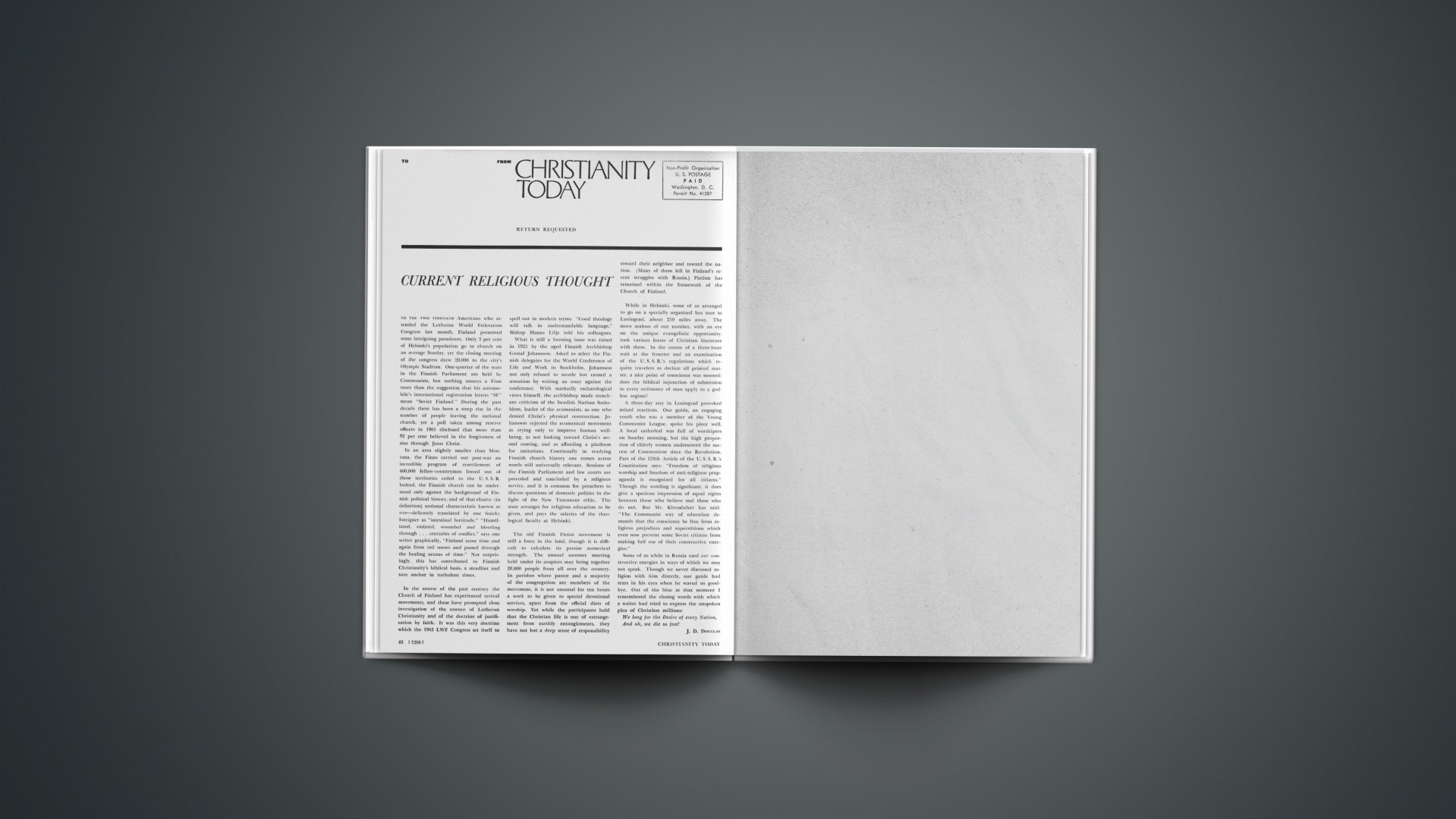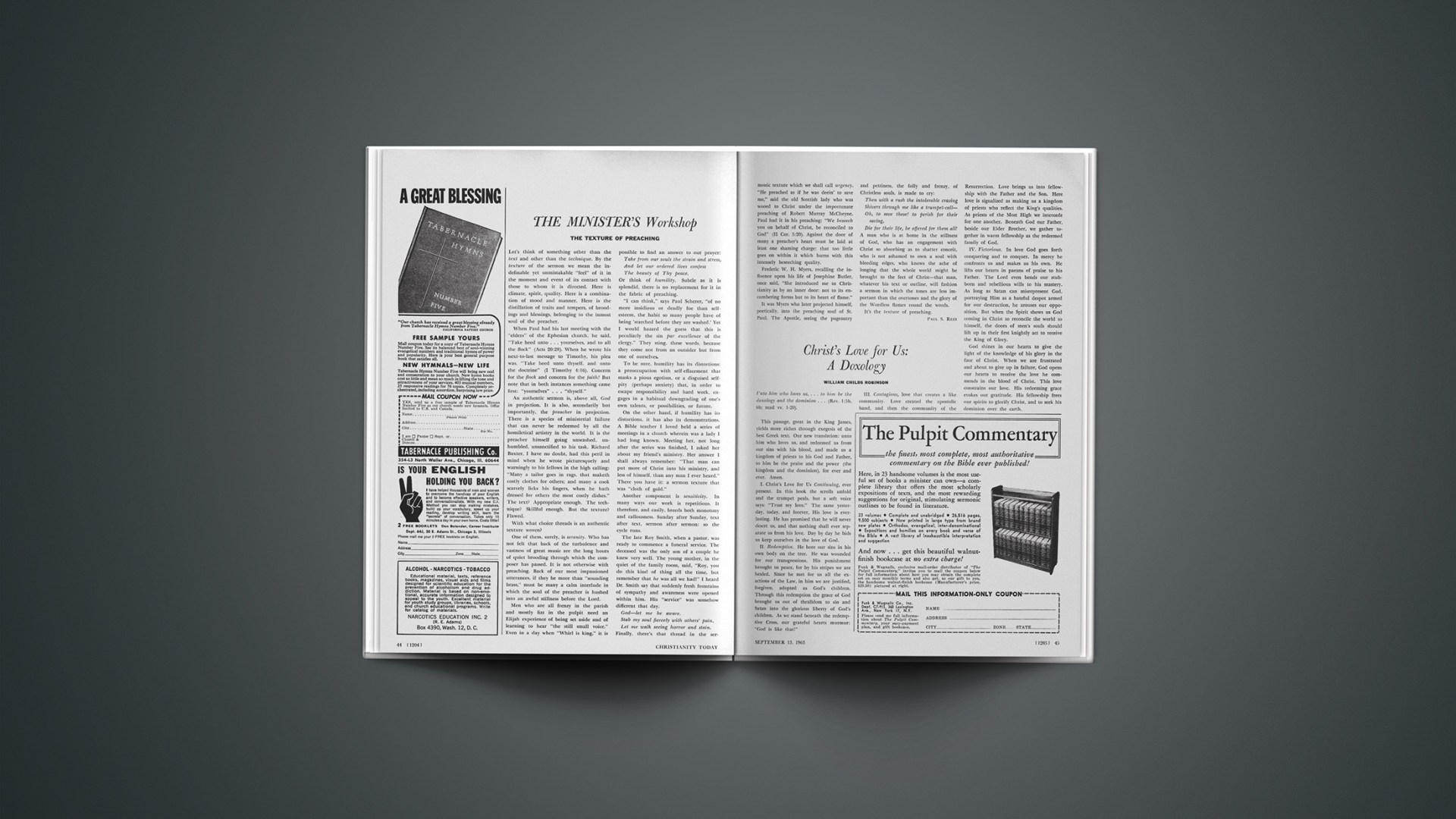Irrelevant And Immaterial
While I was jotting down notes from all over there was this article in the Christian Century called “Notes from an Irrelevant Clergyman.” It was written by Warren Carr, who is said to have “a Baptist church in the South.” What gets Mr. Carr is that in the midst of a big and very sensitive race situation, after Mr. Carr has spoken strongly and clearly on the subject, the committees for his city are all set up and they don’t know how to use him. The current attitude of the layman is seemingly: “Stand aside now. We have a real job to do.”
About two months ago friends of mine were entertaining me in their lovely home and fell to talking about the PTA; from that they launched out on the school board, and there it seemed that someone had concocted a program on the problem of pornography. The word was now moving around town that this program was underwritten by some “shadow” organization, and all kinds of people were getting agitated. The wife of my friend was getting a list of people to telephone for protest, and when she suggested calling the outstanding preacher of the community her husband said, and I quote exactly, “Don’t get the preachers in. They will just confuse things.”
At long last I am working my way through Will Herberg’s Four Existentialist Theologians; the four theologians whom he describes and quotes are Maritain, Berdyaev, Buber, and Tillich. Herberg points out that three of these four men are not clergymen but laymen. Only Tillich is a clergyman, and he is primarily a professional philosopher.
All this sounds a little hard on the clergy. Maybe we have been looking at ourselves in the wrong light or expecting our successes in the wrong direction. We are supposed to sow seeds, not reap crops; if there be any guidance of the Spirit, then we should be operating on the front and the new and the living end. After us and not by us are things to be done.
EUTYCHUS II
The New Format: Yes And No
Congratulations on the fine issue (Aug. 2) with which you began your new format.
Looney Valley and Cedar Valley Lutheran Churches
Houston and La Moille, Minn.
In my opinion the “delightful new format” applies to the cover only!
White Plains, N. Y.
Your new format is an exceptionally hand-some publication.
Bergenfield, N. J.
Please. If necessary sacrifice some of that lonely white space, but give us bigger print. This is awful.
Yucaipa, Calif.
May I commend you on the new cover and format?… I think that you have used your type and white space to great advantage.
Executive Director
Division of Christian Publications
Board of Education and Publication
American Baptist Convention
Valley Forge, Pa.
I do not not like your new format. The type, beginning on page 29 of your August 2 issue, is difficult to read.… I feel that throughout the magazine you are putting too much on a page.…
Chester, Pa.
I want to congratulate you on the new format. It is a very fine one and most inviting in its setup.
Stevenson, Md.
Congratulations on your new format! This is easily the greatest improvement since the addition of those monthly sermons.
Highland Baptist
Huntington, W. Va.
Congratulations to you (and to ourselves) on the new dress in which C. T. appears!
My copy came yesterday. I like it (with a minor reservation here or there).
Vice-Pres.-At-Large
World Vision
Pasadena, Calif.
I sincerely hope the new form is just a temporary lapse. It is impossible to read it easily and comfortably.
Morgans Baptist Church
Moneta, Va.
Your new format is excellent. While redesigning is a catastrophe for some periodicals, it was a distinct gain for you.
Art Director
Board of Education and Publication
General Conference Mennonite Church
Newton, Kan.
Do not like your new format. The old one was far superior and cannot understand what you ever thought was wrong with it.
Warrenville, Ill.
I withdraw criticism of the format.… This number 23 issue looks good and I do not have an old one so I don’t know what I was fussing about in the first place. At any rate, this looks good but not better than what you have had for years.
Warrenville, Ill.
We are gratified over the concern ofCHRISTIANITY TODAYreaders for the magazine’s typographical well-being. To those few readers who have objected to the type’s being “smaller” we merely say this: The Baskerville type we now employ has as wide a character as did our old Fairfield. The height of the character matches that used in The New York Times. Baskerville is authoritatively regarded for superior legibility, and its legibility inCHRISTIANITY TODAYis enhanced by additional leading (space between lines).—ED.
Texas And The Angels
Your August 2 editorial “Christian Vocational Calling” reminded me of the time I applied for a summer job with a paper company which had the policy of subjecting every applicant to a psychological examination. Halfway through my inkblot test I could tell I was upsetting my examiner because I was seeing cherubim, the tables of the Law, and other religious symbols where I probably should have alleged to see more earthily Freudian objects. But I did not realize how far apart our worlds were until he delved into my employment history. I had been on the staff of a Colorado church before being invited to another position in Texas—all of which was before going back to school, as I would again that fall.
The psychologist asked me, “Why did you leave the church in Colorado?”
I made the mistake of saying, “Because I was called down to Texas.”
At this point he leaned over the table and said in that stage whisper used to distract lunatics while the net is encircling them, “Called? Called? Like angel voices perhaps?”
“No,” I replied. “Called—like by long-distance telephone call from a preacher I knew.”
That ended the interview. I never went back to see if I got the job.
Silver Spring, Md.
The dissatisfaction with psychological tests in predictive screening of religious candidates must not be seen as a unique problem. All psychological evaluations are limited in their efficacy and particularly so in predicting success or failure in such a complicated decision as vocational outcome. As with all new procedures, we often hope for more than they can realistically produce. This leaves us open to frustration and denial of the realistic validity of the procedure.…
You quote ironic statements which regard religious personalities as “deviant.” Experience reveals that one will receive help from your consultant in proportion to his understanding of your need. Dr. M. K. Bowers suggests that such collaborative evaluations can only be profitable if the psychotherapist understands and is sympathetic to the religious values of the person and the specific evaluative needs of the institution (Psychotherapy of Religious Personnel in Research Plans in Religion etc.; Rel. Educ. Assn., 1962).…
You note that no one should stand between the called and the Caller. We heartily agree. Nonetheless, my own professional experience and that of my Christian colleagues who also see religious candidates and personnel underscore the difficulty we mortals often have in perceiving the Divine Call. Personal needs and misconceptions
can frequently be attributed to God. If we can help in discovering such spurious calls we may not only obviate misplaced effort but oftentimes turn one toward an actual spiritual fulfillment in an appropriate area.
The selection of Christian vocation deserves our highest attention. But the use of our best human skills should be seen as augmenting rather than interfering with our human decisions. The role of the psychotherapist/evaluator should be one of consultant to individuals and institutions. The ultimate decision must be with the spiritual agencies who must use our contributions as part of the total picture.
Department of Psychiatry
University of Cincinnati
Cincinnati, Ohio
Taxation And The Church
Thank you for an excellent editorial, “What of Religious Tax Exemptions?” (Aug. 2 issue). You have presented the problem of tax exemption for religious organizations in a very fair and comprehensible way.
I can see no difference between a direct form of support for churches through subsidies and an indirect form through tax deductions, either institutional or personal. I submit that many if not most churches draw their lives from the state through these “subsidies” in the form of tax deductions.
As a church member (American Baptist), I value my membership. At the same time, I view dependence upon “outside” support, which includes tax exemptions in my interpretation, as a weakening factor in the life of the church. If the Church is to have strength and respect, it must be completely self-supporting.
Seattle, Wash.
What of the government that engages in tax-exempt enterprises of every description, in unfair competition with private enterprise, forcing its citizens not only to face such unequal competition, but to make up the deficit incurred by government when those business enterprises operate in the red? It seems to me that the government should abide by the same rules that apply to the churches, in so far as moral and legal conduct is concerned.… Furthermore, if only such funds of the church as are spent upon worship and strictly religious education facilities are to be tax-exempt, then the millions spent every year by the World Council and the National Council of Churches in lobbying in Washington in attempting to influence government policies, both foreign and domestic, activities entirely beyond and unrelated to the real mission of the Church, should be taxed to the hilt.
Harlington, Tex.
My Sunday school teacher was a Philadelphia lawyer. He told us that churches were not taxed because it cost less to police a city of churches.… Today crime is on the increase and church attendance is on the decrease. Many churches are closed Sunday evening. In one city a righteous family is driving thirteen miles past churches that are closed to one that is putting on a good evening service. I believe the names of these closed churches should be given to the tax collector. They are not earning an exemption.
Newfield, N. J.
Peter, Caesar, And The Sword
The Rev. William C. Lowe (Eutychus, Aug. 2 issue) raises the question: “But can anyone imagine Jesus Christ taking a gun to defend himself or his disciples?” I find that liberal as well as conservative Bible teachers often fail to exegete the words of our Lord correctly when he said: “Put up thy sword into the sheath: the cup which my Father hath given me, shall I not drink it?” These words were uttered to Peter the Elder of the Church, but never to Caesar the head of the Roman government. God has never sanctioned nor blessed the defense of the Church by the sword whether by the Muenster Anabaptists in 1535, or, by General Thomas Harrison of the “Fifth Monarchy Party” in England in 1661. During the Second World War and the Korean War millions of Christians were praying for the success of our fighting men, including General Harrison.
Faith Community Church
Palmdale, Calif.
Strategy
Though I found Colin C. Campbell’s “Christian Responsibility to Contemporary Literature” (Aug. 2 issue) stimulating … I question certain presuppositions.… Christian responsibility, he asserts, compels us to approach contemporary, secular literary works with an attitude of what we can give to them by “confronting serious works of literary art—reading them, pondering them, debating them with friends, writing about them.” By these methods could a new channel form to carry the leaven of “Christian concepts” into modern literature. One crucial presupposition appears to be operative here. It is the seeming inevitability that current literature “must come under the leavening touch of Christianity,” that “every sort of human activity must feel the impact of Christian concepts” in the future, and that a literature “may well” emerge “fully responsive to the leaven” of Christian ideas. By what authority can we say that Christian concepts will make such an impact.… How consistent is Mr. Campbell’s optimism with orthodoxy’s view of man? Also, by advocating the steady, gradual penetration of elements of “primitive Christianity” as an important vital task, is he being consistent with orthodoxy’s view of salvation? For it is not a gradual process by which man comes to understand his relationship to God, but rather through a more decisive experience.… Thus, such a gradual leavening of secular literature, unless conceived as an improvement of the overall environment, would be less crucial than the improvement of contemporary creative Christian literature. And our responsibility to secular literature would be significantly lessened; not so our responsibility to its writers and avid readers.
Kalamazoo, Mich.
Right Man, Wrong Council
Re “The Receiving End” (News, July 19 issue): The Rev. Daniel Corrigan you identify with the Home Department of the National Council of Churches is, in fact, … the Director of the Home Department of the National Council of the Episcopal Church.
Saint John’s
Cohoes, N. Y.
Nicodemus Today
Re the number of born-again Christians in churches (Editorial, July 19 issue): I made a private survey recently on this very point and thought you might be interested in it. I have been pastor here twenty-one years and so know the congregation well. Here are the results:
Consecrated, active, spiritual 13%
Good interest 27%
Casual interest 31%
Complete backsliders 29%
My observation would lead me to believe that this is about what the situation is in the old-line Protestant churches in this area.
New York State
Your informant, whoever he was, was either irresponsible, not knowing whereof he spoke, or prejudiced against our fellowship.… One of our basic doctrines of our conference churches is that a person must be born again, or “twice-born” as your editorial puts it, before becoming a member of the church. To have indicated that our local churches have but 66 per cent twice-born members has done us grievous harm to our ministry. Letters have come to me since your editorial which question our status.
Gen. Secy.
Baptist General Conference
Chicago, Ill.
Your summary on the number of born-again people in the churches seemed super-abounding in exaggerated optimism.
Skyway Bible Church
Seattle, Wash.
Education: Religion Issue
Thank you very much for your July 5 issue.… It has been helpful in giving to me new insights into the U. S. Supreme Court members’ decision.
I do not agree with their decision entirely for the following reasons …: Protestants in America have now lost some of their religious freedom and liberty because of this prohibition on the free exercise of religion.… This decision goes far beyond the spirit and the intention of the founding fathers … and the framers of the U. S. Constitution.
Westminster Presbyterian Church
Charleston, W. Va.
While reading the June issue of The Atlantic, I was impressed with the implications for Christian education in the article “Higher Education in the 21st Century.”
Could the use of television and programmed learning possibly be the answer to the parochial school problem? Could it possibly point a way for survival for the Christian college?
If a state university could provide quality courses in the sciences and in all forms of laboratory demonstrations and in foreign languages via television, the parochial school could concentrate on the social sciences, humanities, and religious studies.
The same type of service provided to Christian colleges in certain academic areas would narrow the load of the church-related school. A Christian university could take the lead in providing the quality material for television tapes in areas of special Christian concern which are too costly and specialized to warrant unnecessary duplication by smaller schools.
Certainly this idea is not new, but I am unaware of any popular statement of it. Has any foundation been alerted to this potential need? Would not a serious study of this approach possibly pay immeasurable dividends in the next generation?
Immanuel Lutheran
Eugene, Ore.
Living Waters
A prime source of Christian failure today is the lack of Bible reading. Perhaps never before have so many books been in circulation about the Bible and religious aspects of life. But Jesus said, “They have forsaken me”—the fountain of living waters, and have hewed them out cisterns—broken cisterns that just can’t hold water at all.
How can our schools of theology be influenced once again by German thinkers and their cry for “demythologizing” when we have seen what the same sort of thing did for German civilization in 1915 under the title of “Higher Criticism”?
Christianity cannot survive where the Bible itself is not read, for here is where we find the deepest Truth, the surest Way, and the most victorious Life. The strange thing about the Bible is that, unlike other books, the more one reads it the more exciting it gets and the newer it seems. Faith is born or reborn or deepened, tears come to the eyes as the Father speaks—oh! so personally—to his listening son or daughter, and the heart expands to bursting with the entrance of the Holy Spirit as he bears witness to the most heroic, magnetic figure of history—our closest friend and divine Saviour. No amount of books about the Bible (much less those far removed from it) works such miracles in and for the reader. It’s not a few unrelated verses a day that pay such dividends. There’s not a book in the world meant to be read that way, though, of course, the Bible survives better than most under the treatment. Excitement comes when a chapter or more is read in each of the many sections, with continuous reading in each, day by day; then it is the threads begin to shimmer and life takes on another dimension.
So where do we start putting the pieces of our crumbling Christian world together? Perhaps by dusting off the Rock it has to stand on and choosing the foundation stones very carefully, holding them up to the light of truth. We see immediately that American civilization obviously can not be one of these, nor any other national or ethnic society extant. America is not 100 per cent Christian nor is the church—all or any of them. We have become too tainted by the world, and the world has been barely tinged by us. Is it not time for the redeemed of the Lord to say so? Not those who think they’re perfect but those who know they’re nothing, or worse, except as they are saved by the grace of the Lord.
Rye, N.Y.
Not As A Preacher
I want to thank you and your staff personally for an outstanding performance. It is impossible for me to speak as a “preacher,” but for years I have been studying all these various mixed-up confusions of philosophy and theology—only to find myself torn between my personal experience and what “men were saying.”
At long last, a saintly minister-friend of mine directed me to you, and what a Godsend. I cannot thank you enough for the help that I am constantly receiving from [your] pages. For the life of me, I do not understand how you could be any more fair and honest in your appraisals. Accustomed to the validation theory and practice, I, for one, find your “treatment” intelligent, comprehensive, penetrating, and conducive to the real, living, and whole Christianity, which the Spirit of God through Jesus Christ seeks to reveal.
Cheers! to the Editor and his staff. CHRISTIANITY TODAY is “must reading” for any university student—secular or sacred—who purports to be “transformed by the renewing of his mind.” Its scholarship is exciting as it proceeds to hit those nails right on their heads.
South Pasadena, Calif.

